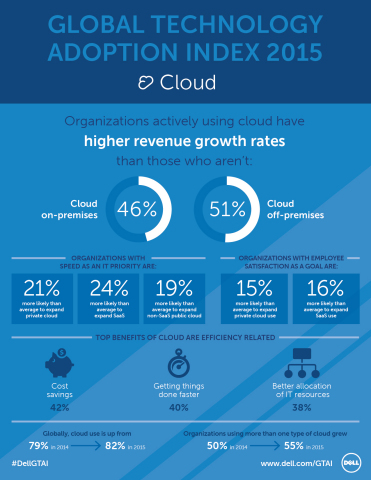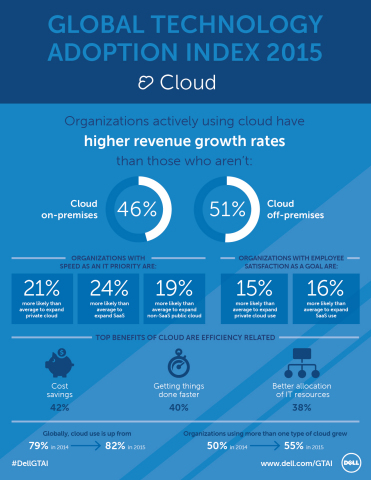ROUND ROCK, Texas--(BUSINESS WIRE)--Today, Dell unveiled the second annual Global Technology Adoption Index (GTAI 2015), revealing that organizations actively using cloud, mobility, big data or security technologies are experiencing up to 53 percent higher revenue growth rates than those that have not invested in these technologies. Despite this strong link between technology use and revenue growth, cost was cited as a main barrier to implementation or expansion of these technologies.
“We’re enthused to see more organizations recognizing the strategic importance of technology investments,” said Paul J. Walsh, CIO, Dell. “We believe this new research will help companies see the correlation between technology use and revenue growth, improved efficiencies and organizational growth.”
In 2014 and again in 2015, the GTAI surveyed IT and business decision makers of mid-market organizations around the world to understand how they perceive, plan for and utilize four key technologies: cloud, mobility, security and big data. Today, Dell is releasing the first wave of global results, with additional industry-specific data to follow in several chapters throughout 2016. Four major global trends emerged from the first wave of findings.
Investment in cloud, mobility, big data and security is correlated with revenue growth
Organizations that have invested in technology are growing faster, recognizing the advantages of security and are becoming more strategic in their security-related investments.
-
Globally, organizations actively using big data, cloud and mobility
have up to 53 percent higher growth rates than organizations not
investing in these technologies. More specifically, those
organizations using:
- Big data experience 50 percent higher growth rates
- On-premises cloud have 46 percent higher growth rates
- Off-premises cloud have 51 percent higher growth rates
- BYOD show 53 percent higher growth rates
- Mobile applications show 44 percent higher growth rates
-
Meanwhile, companies globally are recognizing the advantages of
security and are becoming more strategic in their investments.
- On average, 54 percent of an organization’s security budget is spent on implementing security plans rather than simply reacting to threats.
- In fact, organizations with ‘better security’ as a business goal are more likely to have security plans in place for some or all types of security incidents (69 percent versus 58 percent of their counterparts where ‘better security’ is not a business goal).
These technologies also fuel company benefits, including efficiency and organizational growth goals
The GTAI 2015 found a link between these technologies and organizational efficiency and growth goals.
-
For mobility, improved efficiency is the biggest benefit (39 percent).
Other efficiency-related benefits include:
- Business process improvement (21 percent)
- Reduction in paperwork (21 percent)
-
For cloud, the top three benefits are also efficiency related:
- Cost savings (42 percent)
- Getting things done faster (40 percent)
- Better allocation of IT resources (38 percent)
-
However, for big data, the key benefits are related to driving
competitive advantage and customer growth and retention, including:
- Better targeting of marketing efforts (41 percent - one of last year’s top three goals as well)
- Optimization of ad spend (37 percent)
- Optimization of social media marketing (37 percent)
- In a similar vein, for security, the ability to more quickly respond to market conditions is a key benefit (77 percent of organizations with fledgling IT security programs, and 78 percent of organizations with established security solutions).
Cost joins security as a chief barrier to technology adoption, use and expansion
The 2014 report found that security was by far the biggest barrier to adoption of these technologies. This year, cost became a more pressing concern globally.For big data, cost is the biggest obstacle for organizations not yet using big data and also those currently using it.
-
For organizations that have big data but are not yet using it,
the primary barriers are:
- Not knowing if the benefits are worth the cost (20 percent)
- The cost of IT infrastructure (18 percent)
- The cost is too high to outsource analysis or operations (17 percent)
- For organizations that are currently using big data, the cost of IT infrastructure is the primary barrier (29 percent).
- However, for organizations that are currently using big data, security is the second biggest concern (28 percent).
-
Interestingly, survey respondents with business (i.e., non-IT) titles
see the challenges differently. For them:
- Security is the top barrier (31 percent)
- Cost is secondary (25 percent)
For cloud adoption and usage, cost and security are both large barriers. The top barrier depends on the perceived security level of the cloud type:
-
Higher costs are most frequently top risks of adopting:
- Private cloud, with 28% of organizations citing short-term cost risks and 23% citing long-term cost risks
- Managed private cloud, with 28% of organizations citing short-term cost risks and 23% citing long-term cost risks
- Hybrid cloud, with 30% of organizations citing short-term cost risks and 24% citing long-term cost risks
- Security is the biggest barrier to adoption of public clouds (44 percent) and SaaS (38 percent).
- In general, 42 percent of the small portion of organizations not formally using cloud yet said security issues were the reason—far more than any other reason named.
For mobility, security concerns are the number one barrier to mobility expansion, but cost is the second biggest barrier.
- Security and fear of data breach is the most frequent barrier to expanding mobility (42 percent of organizations).
- Limited budget is the second most frequent barrier to expansion (34 percent of organizations).
-
Other barriers include:
- Limitations of current IT infrastructure (24 percent)
- Too many IT platforms/operating systems to support (23 percent)
- Limited technical/resources (23 percent)
Cost concerns and security challenges seem to go hand in hand. The study found that an organization’s IT budget greatly impacted its level of security planning and implementation.
- Below the $100,000 IT annual spend level, fewer than one in five organizations have comprehensive security plans.
- Below the $25,000 IT annual spend level, fewer than half have formal security plans of any kind.
- Alarmingly, below the $10,000 IT annual spend level, nearly one in five companies have no security policies at all—not even informal guidelines.
Business leaders are the drivers for big data and mobility adoption, but they partner with the IT team for cloud and security
Organizations globally named business teams as leading the adoption of big data and mobility much more frequently than IT teams. This might explain why business decision makers in organizations surveyed were more likely than their IT counterparts to feel their organizations took good advantage of big data.
- Business teams lead adoption of big data 18 percent more often than IT teams.
- They lead adoption of mobility 42 percent more often than IT teams.
However, both business and IT leaders are equally likely to lead adoption of cloud and security, suggesting these teams partner more closely on these initiatives.
Summary and Conclusion
“We knew adopting new technologies would help us become more efficient, but we’ve recognized an even more impressive return on our investment,” said Rick Mears, senior vice president/chief information officer for Owens & Minor. “We have tremendous new capabilities, most of which were funded through the efficiencies we get from Dell solutions and services. This savings has helped us invest in things that really move the dial on our business.”
While companies consider cost a significant barrier to technology adoption, the GTAI 2015 shows that the companies who have allocated budget for meaningful investments in technology have seen overall company growth across several important measurements of progress. From improved efficiency to stronger revenue, cloud, mobility, big data and security technologies are proving to play a key role in company growth and goal attainment.
Supporting Resources
- Visit www.dell.com/GTAI for more information, including infographics, charts and additional results.
About the Global Technology Adoption Index
To develop the GTAI, Dell commissioned global research firm TNS in 2014 and again in 2015 to conduct quantitative surveys with IT and business decision makers worldwide. In 2015, 2,900 employees of mid-market organizations (100-4,999 employees) distributed across 11 countries worldwide and multiple industries were surveyed to enable deep analysis by industry and region. The survey was conducted between June and July 2015, and has a confidence interval of +/- 1.8 percent.
About Dell
Dell Inc. listens to customers and delivers innovative technology and services that give them the power to do more. For more information, visit www.dell.com.
About Dell World
Join us Oct. 20-22 at Dell World 2015, Dell’s flagship event bringing together technology and business professionals to network, share ideas and help co-create a better future. Learn more at www.dellworld.com and follow #DellWorld on Twitter.







